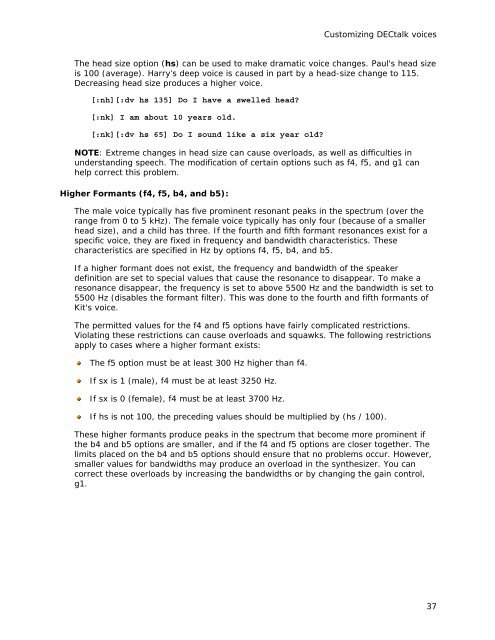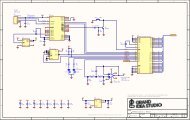Fonix proudly introduces DECtalk version 5.01-E1, the world's most ...
Fonix proudly introduces DECtalk version 5.01-E1, the world's most ...
Fonix proudly introduces DECtalk version 5.01-E1, the world's most ...
Create successful ePaper yourself
Turn your PDF publications into a flip-book with our unique Google optimized e-Paper software.
Customizing <strong>DECtalk</strong> voices<br />
The head size option (hs) can be used to make dramatic voice changes. Paul's head size<br />
is 100 (average). Harry’s deep voice is caused in part by a head-size change to 115.<br />
Decreasing head size produces a higher voice.<br />
[:nh][:dv hs 135] Do I have a swelled head?<br />
[:nk] I am about 10 years old.<br />
[:nk][:dv hs 65] Do I sound like a six year old?<br />
NOTE: Extreme changes in head size can cause overloads, as well as difficulties in<br />
understanding speech. The modification of certain options such as f4, f5, and g1 can<br />
help correct this problem.<br />
Higher Formants (f4, f5, b4, and b5):<br />
The male voice typically has five prominent resonant peaks in <strong>the</strong> spectrum (over <strong>the</strong><br />
range from 0 to 5 kHz). The female voice typically has only four (because of a smaller<br />
head size), and a child has three. If <strong>the</strong> fourth and fifth formant resonances exist for a<br />
specific voice, <strong>the</strong>y are fixed in frequency and bandwidth characteristics. These<br />
characteristics are specified in Hz by options f4, f5, b4, and b5.<br />
If a higher formant does not exist, <strong>the</strong> frequency and bandwidth of <strong>the</strong> speaker<br />
definition are set to special values that cause <strong>the</strong> resonance to disappear. To make a<br />
resonance disappear, <strong>the</strong> frequency is set to above 5500 Hz and <strong>the</strong> bandwidth is set to<br />
5500 Hz (disables <strong>the</strong> formant filter). This was done to <strong>the</strong> fourth and fifth formants of<br />
Kit's voice.<br />
The permitted values for <strong>the</strong> f4 and f5 options have fairly complicated restrictions.<br />
Violating <strong>the</strong>se restrictions can cause overloads and squawks. The following restrictions<br />
apply to cases where a higher formant exists:<br />
The f5 option must be at least 300 Hz higher than f4.<br />
If sx is 1 (male), f4 must be at least 3250 Hz.<br />
If sx is 0 (female), f4 must be at least 3700 Hz.<br />
If hs is not 100, <strong>the</strong> preceding values should be multiplied by (hs / 100).<br />
These higher formants produce peaks in <strong>the</strong> spectrum that become more prominent if<br />
<strong>the</strong> b4 and b5 options are smaller, and if <strong>the</strong> f4 and f5 options are closer toge<strong>the</strong>r. The<br />
limits placed on <strong>the</strong> b4 and b5 options should ensure that no problems occur. However,<br />
smaller values for bandwidths may produce an overload in <strong>the</strong> syn<strong>the</strong>sizer. You can<br />
correct <strong>the</strong>se overloads by increasing <strong>the</strong> bandwidths or by changing <strong>the</strong> gain control,<br />
g1.<br />
37








